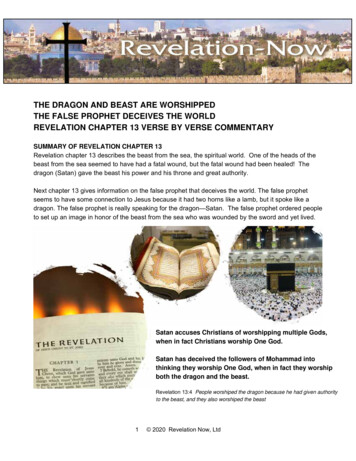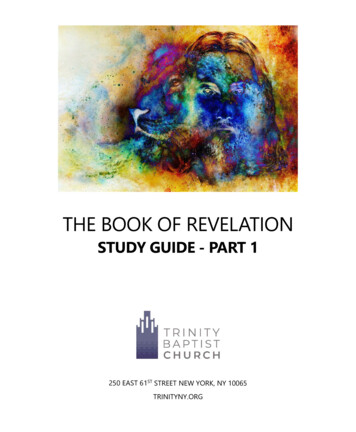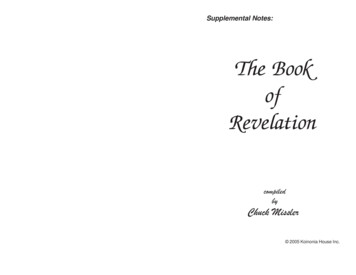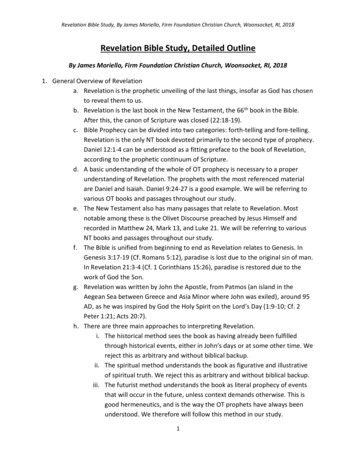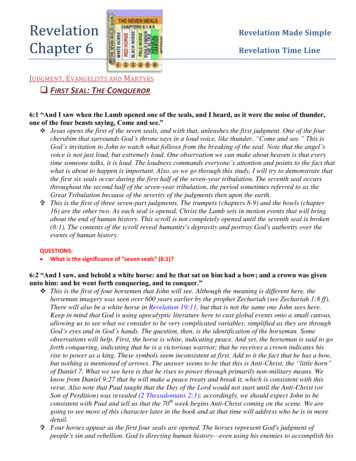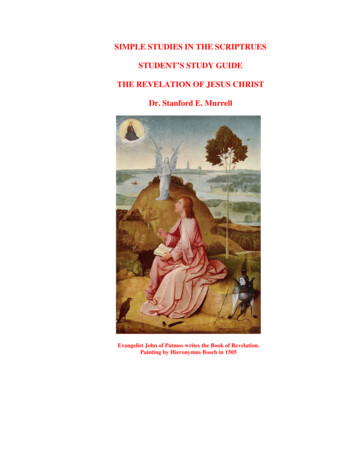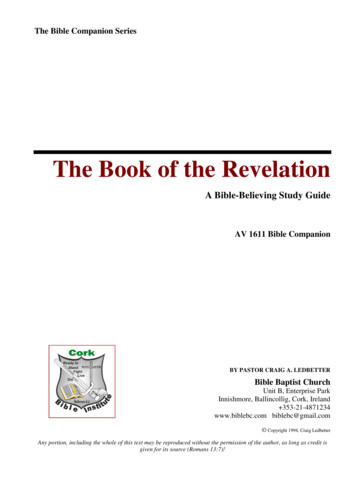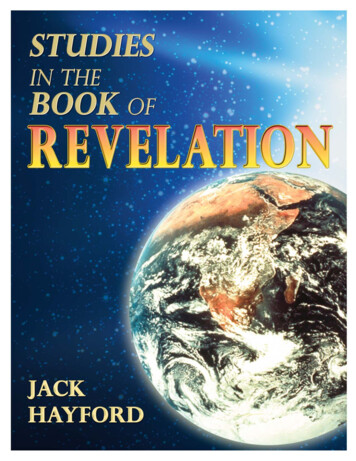
Transcription
THE BEASTOF REVELATION
Other books by Kenneth L. Gentry, Jr.The Christian Case Against Abortion, 1982, rev. 1989i’?z.e ChanLrrnatic Gij of Prophq: A &formed Response to Wap Gru&m,1986, rev. 19897% Christian and Al oholic Beoerages: A Biblical Perspective, 1986, rev. 1989Be@re Jmalem Fed: Dating the Book of Revelation, 1989House Divided: I’7ze Break-up of Dispensatwnal 17wology(with Greg. L. Bahnsen), 19897Ze Greatness of the Great Commisswn:7%z Chtitian Enkr@se in a Fallen World, 1993He Shall Haw Do inwn: A Postmillennial Eschutology, 1992Lord oftb Saved: Getting to the Heart of the Lordship Debate, 1992God3 Law in the Modern World: l%e Continuing Relevance OldT tament Law, 1993Contributions tcxDavid L. Bender, cd., i’h Weljare State: Opposing Viewpoints, 1982.Gary North, cd., Tkeonomy: An Inzrzwd Response, 1992
THE BEASTOF REVELATIONKenneth L. Gentry, Jr.Institute for Christian EconomicsTyler, Texas
Publisher’s Preface G 1989 by Gary NorthCopyright ‘1989 by Kenneth L. Gentry, Jr., Th.D.Second printing with corrections, 1994.All rights reserved, No part of this publication maybe reproduced,stored in a retrieval system, or transmitted in any form or by anymeans, except for brief quotations in critical reviews or articles,without the prior, written permission of the publisher. For itiormation, address D minion Press, Publishers, Post OffIce Box 8204,Fort Worth, Texas 76124.Unless otherwise noted Scripture quotations are from the NewAmerican Standard Bible, ‘The Lockman Foundation 1960, 1962,1963, 1968, 1971, 1972, 1973.Published by the l:nstitute for Christian EconomicsDistributed by Dominion Press, Fort Worth, TexasZjpesetting by Nhq; Pham NpynPrinted in the Uti ted States of AmericaISBN 0-930464-2 [-4Library of Congress Catalog Card Numben 93-134579
Dedicated to theCongregation of theReedy River Presbyterian Churchwhich “endured to the end”through the several years of studies inRevelation that led to the writing of this bookSecond printing produced in memory ofMrs. Sylvia B. Ducknerftithful church organist forReedy River Presbyterian Church1962-1993
TABLE OF CONTENTSPublisher’s Preface by Gary North . . . . . . . . . . . . . . ixPART 1: WHO IS THE BEAST?Introduction . . . . . . . . . . . . . . . . . . . . . . . . . 3l. The Identity of the Beast . . . . . . . . . . . . . . . 92. The Relevance of the Beast . . . . . . . . . . . . . . 213. The Number of the Beast . . . . . . . . . . . . . . . 294. The Character of the Beast . . . . . . . . . . . . . . 405. The Warofthe Beast . . . . . . . . . . . . . . . . . 476. The Worship of the Beast . . . . . . . . . . . . . . . 577. The Revival of the Beast . . . . . . . . . . . . . . . 68PART 2: WHEN WAS REVELATION WRITTEN?8. The Importance of the Date of Revelation . . . . . . 819. The Thematic Evidence . . . . . . . . . . . . . . . 8810. The Political Evidence . . . . . . . . . . . . . .10211. The Architectural Evidence . . . . . . . . . . . . . . 11112. The Ecclesiastical Evidence . . . . . . . . . . . . . . 12913. The Historical Evidence (1) . . . . . . . . . . . . . . 13814. The Historical Evidence (2) . . . . . . . . . . . . . . 14915. Objections to the Early Date. . . . . . . . . . . . . 167Conclusion. . . . . . . . . . . . . . . . . . . . . . . . .182Scripture Index . . . . . . . . . . . . . . . . . . . . . .189General Index . . . . . . . . . . . . . . . . . . . . . .197vii
PUBLISHER’S PREFACEby Gary North1 will raise than up a Pro@et j?om among tlwir brethren, like unto.&e, and r.oillput my wor in hk mouth; and he shall speak unto themall that I shall command him. And it shall cow to jxzss, that whosoeverwill not hearken unto my words which b shall speak in my name, Iwill require it of him. But tlu prophet, which shall presun-u to speaka word in my WMW, which I have not commanded him to speak, orthat shall speak in the nanw of otha gook, euen that proplut shall die.And #thou say in thirw heart, How shall we know the word which ttkLORD bath not spoken? W7WYZ a prophd speaketh in the na of theLORD, z th thing follow not, nor come to pass, that is the thing whichthe LORD kath not spoken, but the prophet bath spoken it @sumptuous : thou shalt not be afraid of him (Deut. 18:18-22).“Oh, boy! A new book on Bible prophecy!” It certainly is. Butit is not a book about the future. It does not make any predictions.It is not about Christian eschatology “the doctrine of last things.”This statement may initially confuse people. How can a bookbe about Bible prophecy but not be about eschatology? Easy. Forexample, a book on the subject of Old Testament propheciesregarding the coming ofJesus the Messiah can certainly be aboutprophecy yet not be about eschatology. “Yes, yes,” you may bethinking, “but what about a book on New Testament prophecy?Surely it has to be about the fiture. There was nothing of prophetic significance that took place in between the New Testamentauthors and today.” But there was: tfu fall ofJerusalem to tk Romanarmy in A.D, 70. That historic event was clearly prophesied by Jesusix
x2%4 Beast ofl?evelatwn(Luke 21:20-24), yet it took place long ago. It took place after theNew Testament writings were finished but long before you or Iappeared on the :;cene.The fact is, tile vast majority of prophecies in the New Testament refer to this crucial event, the event which publicly identifiedthe transition fro m the O1d Covenant to the New Covenant, andwhich also marked the triumph of rabbinic Judaism over priestlyJudaism, Pharisee over Sadducee,] and the synagogue system overthe temple. So cmtral was the destruction of the temple to thefuture of both Christianity and Judaism that Jesus linked it symbolically to His dt;ath and resurrection:Then answe]ed the Jews and said unto him, What sign shewestthou unto us, seeing that thou doest these things? Jesus answeredand said unto them, Destroy this temple, and in three days I willraise it up. Ther said the Jews, Forty and six years was this templein building, and wilt thou rear it up in three days? But he spake ofthe temple of his body (John 2: 18-21).Dating The Book of Revelation“But,” you may be thinking to yoursel “John wrote the Bookof Revelation (ths Apocalypse) in A.D. 96. Everyone agrees on1. The Sadducee sect ofJudaism disappeared, since it had been associated withthe priests who oilicia .ed at the temple. Herbert Danby, whose English translationof the Mishnah is still considered authoritative by the scholarly world, both Jew andgentile, commented on the undisputed triumph of Phansaism after the fall ofJerusaIem (which lives on as Orthodox Judaism). “Until the destruction of the SecondTemple in A.D. 70 they had counted as one only among the schools of thought whichplayed a part in Jewist national and religious lif after the Destruction they took theposition, naturally and almost immediately, of sole and undisputed leaders of suchJewish life as survived. Judaism aa it has continued since is, if not their creation, atleast a faith and a reli #ous institution largely of their fmhionin and the Mishnahis the authoritative record of their labour. Thus it comes about that while Judaismand Christianity alike venerate the Old Testament as canonical Scripture, the Mishnahmarks the passage to J daism as definitely as the New Testament marks the paasageto Christianity.” Herb wt Danby, “Introduction,” 7%z Miduurh (New York: OtiordUniversity Press, [1933] 1987), p. xiii. The Mkhnah is the written version of theJews’ oral tradition, while the rabbis’ comments on it are called Gemara. The Talmudcontains both Mishna h and Gemara. See also R. Travers Herford, 7?u Phurisea(Londorx Geo e Allen & Unwin, 1924).
Publtihd Prefacexithis. Thus, John could not have been prophesying events associated with the fall of Jerusalem, an event that had taken place aquarter of a century earlier.” This is the argument of DallasTheological Seminary professor Wayne House and Pastor TommyIce in their theologically creative but highly precarious revision oftraditional dispensationalism.2 It is also the intellectual strategytaken by best-selling dispensational author Dave Hunt, who writesin his recent defense of Christian cultural surrender to humanismthat “the Book of Revelation was written at least 20 years afterA.D. 70, most likely about A.D. 96. This one fact destroys thisentire theory” about the fall of Jerusalem being the prophesiedevent that many today call the Great Tnbulation.3 But like somuch of what Dave Hunt has written,4 this “fact” is not a fact.John did not write the Book of Revelation in A.D. 96.When did John write the Book of Revelation? This technicalacademic question must be answered accurately if we are ever tomake sense of New Testament prophecy. Establishing the date ofJohn’s Ap oca 1ypse and the events that followed within a fewmonths of this revelation is what The Beast of Reuelatwn is all about,as is Dr. Gentry’s larger and far more detailed study, Be&eJerusalem Fell: Bating the Book ofllevelation (Institute for ChristianEconomics, 1989). If his thesis is correct, then the “last days” arenot ahead of us; they are long behind us. And if the “last days” arebehind us, then all “futurism” – dispensationalism, most contemporary non-dispensational premillennialism, and the more popularforms of amillennialism — is dead wrong. Anyone who says that“dark days are ahead of the church because the Man of Sin issurely coming” is a futurists Thus, this book is not simply an2. H. Wayne House and Thomas D. 1., Dominion lleologx Curse or Blessing?(Portland, Oregom Multnomah, 1988), pp. 249-60.3. Dave Hunt, Whatevsr Hap@ted to Heawm? (Eugene, Oregon Harvest House,1988), p. 249.4. Gary DeMar and Peter J. Leithar The Redu&n of Ckirtianity: A 13ibliaalRssponse to Dave Hunt (Ft. Worth, Texas: Dominion Press, 1988).5. The other positions are idealism, the church hktorieal approach, and preterism. The first view does not try to tie the prophech to any particular post-New
xiiThe Beast @l?evelationobscure academic exercise. If futurists prove incapable of refutingit and its larger companion volume, they have surrendered theirintellectual position.Silence in th Face cj’Ctiticism Is SuicidulIt is my opinion that they will prove incapable of refitingGentry’s evidence, It is my opinion that dispensationalists will noteven try; they will instead adopt the traditional academic strategythat dispensational seminary professors have used for over half acentury to deal wth any book that chzillenges their system: “Let’skeep quiet and pray that nobody in our camp finds out about this,especially our bri{:hter students.”The best example of this keep-quiet-and-hope strategy is theunwillingness of any dispensational scholar to challenge postmillennialist Oswald T. Allis’ comprehensive critique of dispensationalism, Pro hql and the Church (1945) for two decades.6 CharlesC. Ryrie’s brie popularly written, and intellectually undistinguished attempt to refhte a careftily selected handfti of Allis’arguments appeared in 1965: Di@ensationah3rn Today.7 The factthat this slim volume is still the primary ddlense of traditional(Dallas Seminaryl dispensationalism, despite the fact that it hasnever been revised, testifies to the head-in-the-sand approach ofthe dispensationaht world to its Bible-believing critics. This dearthof intellectual defenses is especially noticeable today, given the factof Dr. Ryrie’s unexpected and somewhat acrimonious departurefrom the Dallas Seminary faculty several years ago. Another examTkstament event. The ,mophecies are seen as merely principles. Church hstoricismteaches that the Book of Revelation describes the course of history. This was thecommon view of the Reformation, in which all Protestant groups identified thePapacy as the antichrist. (This was the only universally agreed-upon specificallyProtestant doctrine tha: united all Protestant groups.) The preterists are those whobelieve that most Bible propheck had been fulfilled by the time Jerusalem fell, or atleast by the time the Roman Empire was Christianized. This is my view, Gent@s,and Chilton’s.6. Phillipsburg, New Jemey Presbyterian & Reformed.7. Chicag Moody Press.
Publz3h3 Prefme.mple is their silence regarding WiJJiam Everett Bell’s 1967 NewYork University doctoral dissertation, “A Critical Evaluation ofthe Pretribulation Rapture Doctrine in Christian Eschatology,”which has been reprinted by Bell. Major books deserve full-scalerefutations in books, not simply brief negative book reviews in thein-house, small-circulation journal. Any philosophical, theological,or ideological system that is not defended intellectuzdly and publicly by its academic spokesmen, decade afiter decade, despite agrowing mountain of cogent criticisms, is close to the end of itsinfluence. Its brighter, younger recruits will drift away or else berecruited by the critics. Eventually, the defending institutions willdrift theologically, as formerly dispensational Talbot TheologicalSeminary did after 1986. A defensive mentality, a “form a circlewith the wagons” mentality, cannot be sustained forever. If amovement does not move forward, it either stagnates or movesbackward culturally. If a movement adopts a view of time whichsays that cultural progress in term’s of the movement’s worldviewis unsustainable, and that only “upward” movement or “inward”movenent is truly significant, then the movement has drunk theeschatological equivalent of Jim Jones’ Kool-Aid. This analyticprinciple applies equally well to the New Age mystic’s quest forinner escape or the dispensationalist’s rapture fkver. This is whydispensationalism is dying.Bible-believing Christians need an alternative.8The Last DaysThis book is about the last days. It is not about the end times.The last days are different from the end times. The last days arenot in the present or in the future; they are in the past. Stillconfised? So are millions of other Christians. The confusion stemsfrom the fact that Christians have jumped to the conclusion – awholly erroneous conclusion — that the “last days” spoken of inthe New Testament refer to the last days of the church (or to the8. Gary North, lhcondi W Summder: God’s Program j? Wory (3rd cd.; Tyler,Tex Institute for Christian Economics, 1988).
xivZb Beast of Revelatwnmisleadingly ider tified “Church Age”). This conclusion is notwarranted by the various biblical texts. Zh lust days spoken of in tr!wNzo Testament wen eschatological last days on for national Israel, notj3rthe Nw Couenant d!urch. The “last days” were in fact the early daysof the church ofJcsus Christ.How do we know this? How do we know that we are not nowliving in the last days and never will be? How do we know that theNew Testament was written in the last days, which came to a closeover 1,900 years ago? Because the New Testament clearly says so.The author of the Epistle to the Hebrews spetilcally identified hisown era as the “last days.” He wrote that God “Hath in these lastdqs spoken unto m by his Son, whom he bath appointed heir ofall things, by whom also he made the worlds” (Heb. 1:2). He wasquite clear he and his contemporaries were living in the last days.l%e Destruction of tie TmpleSo, we need to ask this obvious question: The last days ofwhat? The answer is clear: the last days of the Old Covenant, includingnational Israel. The New Testament writers were living in th Mdqu of animal sacn fces in th temple. This is the primary message ofthe Epistle to the Hebrews: the coming of a better sacrifice, aonce-and-for-all s crifice, Jesus Christ. We read: “And for thiscause he is the mediator of the new testament, that by means ofdeath, for the redemption of the transgressions that were under thefirst testament, they which are called might receive the promise ofeternal inheritmm:. For where a testament is, there must also ofnecessity be the dt ath of the testator” (Heb. 9:15-16). The inescapable concomitant of Jesus’ sacrifice at Calvary was His annulmentof the Old Covenant’s sactilcial system:And almost all things arc by the law purged with blood; andwithout sheddin ; of blood is no remission. It was therefore necessary that the patterns of things in the heavens should be purifiedwith these; but tk e heavenly things themselves with better sacrificesthan these. For Christ is not entered into the holy places made withhands, which are the figures of the true; but into heaven itsti, nowto appear in the presence of God for us: Nor yet that he should offer
Publish? Prefmexvhimself often, as the high priest entereth into the holy place everyyear with blood of othem, For then must he often have suiieredsince the foundation of the world: but now once in tlw end of thworld bath he appeared to put away sin by the sacrifice of himself.And as it is appointed unto men once to die, but after this thejudgmenti So Christ was once offered to bear the sins of man% andunto them that look for him shall he appear the second timewithout sin unto salvation. For the law having a shadow of goodthings to come, and not the very image of the things, can neverwith those sacrifices which they offered year by year continuallymake the comers thereunto petiect. For then would they not haveceased to be offered? Because that the worshippem once purgedshould have had no more conscience of sins. But in those sacrificesthere is a remembrance again made of sins every year. For it is notpossible that the blood of bulls and of goats should take away sins.Wherefore when he cometh into the world, he saith, Sacrifice andoffering thou wouldest not, but a body hast thou prepared me: Inburnt offerings and sacfices for sin thou hast had no pleasure(Heb. 9:22-10:7).Notice the key phrase “in the end of the world.” In the originalGreek, it reads: “completion of the ages.” This phrase must betaken literally, but its literal frame of reference was the fall ofJerusalem and the annulment of the temple’s sacrificial system.The author was therefore prophesying the imminent end of national Israel as God’s covenant people.gThe leaders of national Israel had refused to believe Jesus.Subsequently, they refused to believe the message of the apostles.They did not admit to themselves the truth of what the NewTestament message announced, namely, that God has no permanentplemure in burnt animul oflerings. This had been the message of theOld Covenant, too, and their religious predecessors had paid no9. Remans 11 teaches that Israel as a separate corporate people will be convertedto Christ at some point in the fiture. On thk point, one denied by virtually allamillennial commentators, see the postmillennial commentaries by Robert Haldane,Charles Hedge, and John Mun-ay. Nevertheless, the Jews will regain their status asa covenant people only through adoption into the church, just as all sinners do. Theywill not be treated by God cMerently horn any other covenanted people.
xvi% Beast ofRevelatwnattention: “For I desired mercy, and not saerific and the knowledge of God more than burnt offerings” (Hos. 6:6). The NewTestament authols deelared that God would soon bring an end tothese fide and misleading animal sacrifices, never to be restored.ioThey understood that they were living in the last days of the OldCovenant era, and they warned their readers of this fact. This, infact, is the primar y message of the Book of Revelation.l*So, the New Testament authors did write about propheey, butmost (though not all) of their prophetic messages dealt with theimmediate fate and future of national Israel. Thus, when theywrote prophetiea.lly, they wrote primarily about lsraelt near-termeschatolo (last days), not the church’s long-term esehatology(end times). They were writing prophetic warnings to people oftheir own era regarding crises that were almost upon them, notcrises of Christians and Jews living at least 1,900 years later.Let me ask an obvious question, which futurists never publiclyask If your church were in the early stages of a lifiiand-death10. Tmditiond dispensationahsm teaches that the temple will be rebuilt andanimal sacrifices will be restored for a thousand years, even though only as a“memorial,” as C. I. S afield says in his reference note on Ezekiel 43:19. Z% Scojdd&faena Bible (New York Oxford Universi Press, 1909), p. 890. The embarrassment of tie New Scofihi BibM revision committee is apparent in the note that thisprophecy of restored sacrifices can be explained either in terms of the “memorial”thesis (which they stmtegically refie to identi as Sccdield’s original view) or asfigurative - a startling suggestion fi-om theologians who proclaim that dispensationalism’s principle of inte Tretation is “literal whenever possible” (i.e., “literal wheneverconvenient”). X% New Scofdd Bible (New York Oxford University Press, 1967), p.888. If the temple is to be rebuilt for use during the New Testament’s millennium-adispensational doctrine which the revision committee did not dare to challenge – thenfor what other purpose would the temple be used except for offering animal sacrifices?As a tourist attraction? llms, if the rebuilt temple of Ezekiel 43 is a prophecy referringto a New Testament er, millennium rather than to the rebuilt temple of Nehemiah’sday, itself a prophetic symbol of worship in the worldwide church – which is myview – then the re-csta blishment animal sacritica cannot sensibly be regarded asfigurative. But the theological implications of this re-established animal sacrificesystem were too embalmssing for the Scofield revision committee to handle forthrightly. They tidged.11. David Chilton, 1% Days of Vengeanm An Exfiosition of h Book of Rsvekzh”on (Ft.Wordc Dominion Press, 1987).
Publisher% Prefaexviicrisis — the public execution of the church’s founder – and hegave you a warning regarding problems that would face Christianstwo thousand years from now, would you regard his warning astimely, filly rational, and relevant to your immediate needs? Wouldyou regard this warning as being of crucial importance to yourdaily walk before God or the lfe of the local church? No? Neitherwould I. Neither would Jesu.s’ listemm. Therefore, I conclude that theimmediacy of the disciples’ concern was why Jesus warned themof the coming tribulation of national Israel: “Now learn a parableof the fig treq When his branch is yet tender, and putteth forthleaves, ye know that summer is nigh: So likewise ye, when ye shallsee all these tl-ings, know that it is near, even at the doors. VerilyI say unto you, This generation shall not pass, till all these tk@gsbe fulfilled” (Matt. 2432-34).Another question: If that hypothetical warning from the founder referred to events that will be seen by “this generation,” wouldyou instinctively conclude - as all dispensational expositors of thisverse have concluded and must conclude, given their need acoherent system of interpretation- that the phrase “this generation” refers to some generation living at least 1,950 years later?No? Then why not take Jesus’ words literally? “Verily I say untoyou, This generation shall not pass, till all these things be fi-dfilled.”All of these things were fulfilled. In A.D. 70.But What About the Beast?Well, what about the beast? If my thesis is correct – that thephrase “the last days” refers to the last days of Old CovenantIsrael and the destruction of the temple in A.D. 70 – then whowas the beast? After all, if New Testament prophecies regardingthe beast were not fulfilled during the lifetime of John, but referto some individual still in the church’s future, there would seemto be no reason to believe that the other prophecies regarding “thelast days” were also fulfdled in his day. These prophecies must betaken as a unit. It is clear that the beast is a figure who is said tobe alive in the last days. This is why it is imperative that we
.XvlllT/w Beret of Revelatwndiscover who the beast is or was. If he has not yet appeared, thenthe last days mu ;t also be ahead of us, unless we have actuallyentered into them. If he has already appeared, then the last daysare over.This book identifies the prophesied beast beyond any reasonable doubt. This much I will tell you now: it is not Henry Kissinger.If all of the Iotential buyers of Z7ze Beast of Revelation were todiscover in advance that it is not filled with prophecies aboutbrain-implanted computer chips, tatoos with identification numbers, cobra helicopters, nuclear war, and New Age conspiracies,most of them would not buy it. Customens of most Christianbookstores too often prefer to be excited by the misinformationprovided by a string of paperback false prophecies than to becoflorted by the knowledge that the so-called Great Tribulationis long behind u , and that it was Israel’s tribulation, not thechurch’s. (For biblical proo see David Chilton’s book, Z7z.e GreatTribulation.) 12 They want thrills and chills, not accurate Bibleexposition; they want a string of “secret insights,” not historicalknowledge. Like legions of imaginative children sitting in front ofthe family radio back in the 1930’s and 1940’s who faithfullybought their Oval tine, tore off the wrapper, and sent it in to receivean official “Little Orphan Annie secret decoder,” fimdamentalistChristians are repeatedly lured by the tempting promise that theycan be “the first ones on their block” to be “on the inside” — tobe the early recipimts of the “inside dope.” And that is just exactlywhat they have bc en sold, decade after decade.Nine-year-old children were not totally deceived in 1938. Theyknew the difference between real Me and make-believe. Make-believe was thrilling; it was fun; it was inexpensive but it was notreal. The decoded make-believe secrets turned out to provide onlyfleeting excitement, but at, least they could drink the Ovaltine.Furthermore, children eventually grow up, grow tired of Ovaltine,and stop ordering secret decoders.12. David Chilton, 7k.e Great Tribuhion (Ft. Worth, Texas: Dominion Press, 1987).
Pubhsh.d PrefmexixWhen will Christians grow up? When will they grow tired ofan endless stream of the paperback equivalent of secret decoders?When wiJl they be able to say of themselves as Paul said of himself“When I was a child, I spake as a child, I understood as a child,I thought as a child: but when I became a man, I put awaychildish things” (1 Cor. 13:11)?False Prophecies for Fun and ProfitThose Christians who believe that we are drawing close to thelast days are continually trying to iden@ both the beast and theantichrist. This game of “find the beast and identi the antichrist”has become the adult Christians’ version of the child’s game of pinthe tail on the donkey. Every fw years, the participants placeblindfolds over their eyes, turn around six times, and marchtoward the wall. Sometimes they march out the door and over acliff, as was the case with Edgar C. Whisenant, whose best-sellingtwo-part book announced in the summer of 1988 that Jesus wouldsurely appear to rapture His church during Rosh Hashanah weekin mid-September. Half the book was called On Borrowed Timz.The other was more aptly titled, 88 Reaons why th Rapture is in1988. I can think of one key argument why his book’s thesis wasincorrecb no rapture so far, and it is now February, 1989. So muchfor all 88 arguments. The anti-Christian world got another greatlaugh at the expense of millions of fundamentalists who had boughtand read his two-part book. The story of Mr. Whisenant’s bookwas front-page news briefly around the U.S. But Mr. Whisenantis now ancient history, one more forgotten laughingstock whobrought reproach to the church of Jesus Christ while he piled uphis press clippings.This is the whole problem. The victims selkmsciously forgetthe last self-proclaimed expert in Bible prophecy whose predictionsdid not come to pass. They never learn to recognize the next falseprophet because they refuse to admit to themselves that they hadbeen suckered by the last one. Thus, this sucker’s game has beengoing on throughout the twentieth century, generation after gen-
xx% Beast of Revelatwneration, a pathetis story chronicled superbly by Dwight Wilson inhis well-documented book, Armageddon Now!, a book that was notregularly assigned to students at Dallas Seminary, I can assureyou.*3 Again and again, some prominent world political figure hasbeen identified as either the beast or the antichnsti Lenin, Mussolini, Hitler, Stalin, and even Henry Kissinger.14 (It was President Reagan’s good fortune that he was a conservative so belovedby fundamentalists, given the remarkable structure of his nameRonald [6] Wilson [6] Reagan [6].)The back cov:r promotional copy of former best-selling authorSalem Kirban’s self-published book, 17u Rise of Anti-Christ, isrepresentative of :his paperback prophetic literature. Published in1978, it boldly an ounced:We are already living in theAGE OF ANTICHRIST!The world is on the threshold of catastrophe. Scientific advances are really scientific tragedies that will spell chaos, confmionand terror.Wlthinthenext 5years . . .DESIGN YOUR OWN CHILDby going to the “genetic supermarket.”YOUR MIND WILL BE PROGRAMMEDwithout your knowing it!Within the next 10 yeara . . .YOUR BRAIN WILL BE CONTROLLEDby outside sources!YOUR MEMORY WILL BE TRANSFERREDinto a live embryo.13. Dwight Whn, Amw.geddon Now! Th Premillennial Response to Russia and IsraELSize 1917 (Grand Rapids, Michigan: Baker Book House, 1977).14. Salem Kirban, Ki.ssingeY: Man of Peace? (Huntington Valley, PennsylvaniaSalem Kirban Irq 1 74). As you might expect, thk book is no longer in print. Itsometimes appem in 1 ocal library bcok sales for a dollar or less. If you spot it, buyit. It is a classic.
Publisher PrefacexxiAnd so on. None of this has happened, of course. My favorite isthis one “HEAD TRANSPLANTS will become a reality.” Iwonder who will be the first two volunteers? Who will get what?This book is to Bible exposition what the National Enquirer is tojournalism. (The trouble is, the National Enquirer sells 7 millionco
Dating The Book of Revelation “But,” you may be thinking toyoursel “John wrote the Book of Revelation(ths Apocalypse) in A.D. 96. Everyone agrees on 1. The Sadducee sect ofJudaism disappeared, since it had been associated with the priests who oilicia .e
